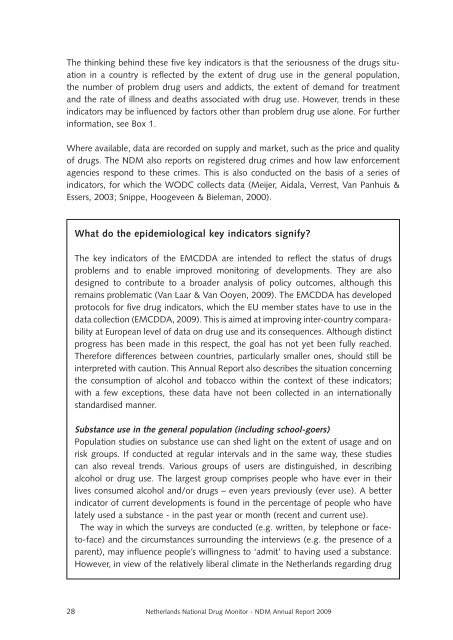Netherlands National Drug Monitor - Research and Documentation ...
Netherlands National Drug Monitor - Research and Documentation ...
Netherlands National Drug Monitor - Research and Documentation ...
Create successful ePaper yourself
Turn your PDF publications into a flip-book with our unique Google optimized e-Paper software.
The thinking behind these five key indicators is that the seriousness of the drugs situation<br />
in a country is reflected by the extent of drug use in the general population,<br />
the number of problem drug users <strong>and</strong> addicts, the extent of dem<strong>and</strong> for treatment<br />
<strong>and</strong> the rate of illness <strong>and</strong> deaths associated with drug use. However, trends in these<br />
indicators may be influenced by factors other than problem drug use alone. For further<br />
information, see Box 1.<br />
Where available, data are recorded on supply <strong>and</strong> market, such as the price <strong>and</strong> quality<br />
of drugs. The NDM also reports on registered drug crimes <strong>and</strong> how law enforcement<br />
agencies respond to these crimes. This is also conducted on the basis of a series of<br />
indicators, for which the WODC collects data (Meijer, Aidala, Verrest, Van Panhuis &<br />
Essers, 2003; Snippe, Hoogeveen & Bieleman, 2000).<br />
What do the epidemiological key indicators signify<br />
The key indicators of the EMCDDA are intended to reflect the status of drugs<br />
problems <strong>and</strong> to enable improved monitoring of developments. They are also<br />
designed to contribute to a broader analysis of policy outcomes, although this<br />
remains problematic (Van Laar & Van Ooyen, 2009). The EMCDDA has developed<br />
protocols for five drug indicators, which the EU member states have to use in the<br />
data collection (EMCDDA, 2009). This is aimed at improving inter-country comparability<br />
at European level of data on drug use <strong>and</strong> its consequences. Although distinct<br />
progress has been made in this respect, the goal has not yet been fully reached.<br />
Therefore differences between countries, particularly smaller ones, should still be<br />
interpreted with caution. This Annual Report also describes the situation concerning<br />
the consumption of alcohol <strong>and</strong> tobacco within the context of these indicators;<br />
with a few exceptions, these data have not been collected in an internationally<br />
st<strong>and</strong>ardised manner.<br />
Substance use in the general population (including school-goers)<br />
Population studies on substance use can shed light on the extent of usage <strong>and</strong> on<br />
risk groups. If conducted at regular intervals <strong>and</strong> in the same way, these studies<br />
can also reveal trends. Various groups of users are distinguished, in describing<br />
alcohol or drug use. The largest group comprises people who have ever in their<br />
lives consumed alcohol <strong>and</strong>/or drugs – even years previously (ever use). A better<br />
indicator of current developments is found in the percentage of people who have<br />
lately used a substance - in the past year or month (recent <strong>and</strong> current use).<br />
The way in which the surveys are conducted (e.g. written, by telephone or faceto-face)<br />
<strong>and</strong> the circumstances surrounding the interviews (e.g. the presence of a<br />
parent), may influence people’s willingness to ‘admit’ to having used a substance.<br />
However, in view of the relatively liberal climate in the <strong>Netherl<strong>and</strong>s</strong> regarding drug<br />
28 <strong>Netherl<strong>and</strong>s</strong> <strong>National</strong> <strong>Drug</strong> <strong>Monitor</strong> - NDM Annual Report 2009




